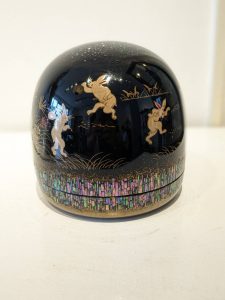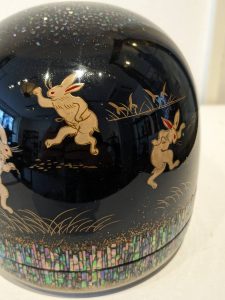今週末は「覚王山夏祭」です!!(愛知県名古屋市千種区姫池通 骨董買取 古美術風光舎)
2025.07.21

いよいよ今週末、7月26日(土)、27日(日)16:00~21:00「覚王山夏祭」が開催されます。
参道に様々なお店が並び、いつもの覚王山のお店が、祭の日ならではのお店になります。キッチンカ―など外部からのお店も並びますので、楽しさ倍増です。
また懐かしのゲームコーナーでは、
・コリント
・ストラックアウト
・コロコロぽん
・バターゴルフ
・輪投げ
・ヨ一ヨ一風船つり (※ゲームの種類は、状況により当日変更になる場合もあるとのこと。)
などが楽しめるそうですよ。なんと、このゲームコーナーのゲームは、30年近く前、商店主さんや地域の方々で手作りしたものなのだそう。お子様のパパママが子ども時代に、お祭りで遊んでたものだと思うと感慨深いですね。童心に戻って、大人も楽しめそうです。
このところの風光舎ブログにも多く出てきております「今年も盛り上がろう愛知の夏祭りブログ」のおかげか、いつもよりは夏祭りに敏感に反応している気がしているような、夏が苦手なスタッフT。
夏が苦手な私でも、日本の夏祭りと言われて思い浮かぶイメージの中には、「盆踊り」の光景があります。その名の通り、お盆の時期に神社やお寺、地域の広場などで行われるもので、夏を代表する風物詩としても広く愛されている催し物です。
ここ覚王山でも、日泰寺で2025年8月5日(火)・6(水) 「 納涼盆おどり」が開催されます。
全国各地でさまざまな形の盆踊りが受け継がれていますが、主にやぐらを組んでその周りを輪になって回りながら踊る輪踊りの形式と、列を組んで練り歩く行列の形式の二種類が一般的。
また、誰でも気軽に踊りに参加できる形と、踊り手が決まっていてそれを見て楽しむ形とがあります。
老若男女を問わず誰でも参加できるうえ、振り付けも難しすぎないので見様見真似ですぐに踊れて、近くで見ていると思わず体を動かしたくなってくる不思議な魅力を持っています。
盆踊りは、ただお祭りとして賑やかに楽しむだけの踊りではなく、本来はお盆にこちらの世界に帰ってきた故人やご先祖様の霊をおもてなしして、ふたたび魂があの世へ戻ってゆくのを見送る、供養の意味が込められた行事です。
お盆は13日から16日までの期間ですが、13日の夜に迎え火を焚いてご先祖の霊をお迎えし、多くの地域で15日の夜に盆踊りが行われます。そして、16日の夜には送り火とともに、ご先祖様の霊を送り出すという風習になっているのも、そういった理由があります。
盆踊りの歴史は古く、平安時代の空也上人(くうやしょうにん)によって始められた踊念仏(おどりねんぶつ)が起源とされています。空也上人といえば、開いた口から小さな阿弥陀如来像が6体現れている立像が有名ですね。教科書にも出てきたアレです。京都の六波羅蜜寺(ろくはらみつじ)に安置されているものが有名で、空也上人が「南無阿弥陀仏」と唱えた際に、その声が阿弥陀如来の姿になったことを表現したものです。
そして、空也上人によって始められた踊念仏を、鎌倉時代に一遍上人(いっぺんしょうにん)が全国を行脚して庶民にまで広め、それが仏教の「盂蘭盆会(うらぼんえ)」という死者を供養する行事と結びついて現在のような形になっていったと言われています。本来の踊念仏は宗教性の高いものでしたが、これが民衆に受け入れられると、芸能性が重視され、太鼓と唄に合わせて踊るようになったとされています。
また、盆踊りには地域社会の結束を強めるという要素もあり、江戸時代には近所の人々の交流や男女の出会いの場としても、貴重な楽しみの場となっていたようです。
現代においても、お盆は、里帰りをして家族や懐かしい友人と久しぶりに再会する機会になっていますよね。
本来、旧暦の盆踊りの晩は満月でしたので、照明がなくても月明りに照らされながらみんなで賑やかに過ごすことができたのでしょう。
「日本三大盆踊り」としては、徳島の阿波踊り、秋田の西馬音内(にしもない)の盆踊り、岐阜の郡上踊りが挙げられていますが、その他にも数え切れないほど全国各地で開催され、それぞれのスタイルで盆踊りが親しまれています。
皆さまがお住まいの地域でも、近隣で盆踊りが開催されているでしょうか?
各地の有名な盆踊りを見物に、もちろん踊りに行くのもよいですが、地元で盆踊りが開催されているなら、覗いてみるのも良いかもしれませんね。
ちなみに、名古屋があります尾張地方では、盆踊りといえば「ダンシング・ヒーロー」なんですが、ご存知でしたか?「なんで?」と思うのですが、定番なのですよ。
ではでは、また。(スタッフT)

Finally, the “Kakuozan Summer Festival” will be held this weekend, July 26 (Sat.) and 27 (Sun.) from 16:00 to 21:00.
Various stores will line the approach to the festival, and the usual stores of Kakuozan will be transformed into special stores for the festival. The fun will be doubled with the presence of outside stores such as kitchen cars.
Also, at the nostalgic game corner, there will be
Corinthian
・Struckout
・Korokoro Pon
・Butter Golf
・Ring Throw
・Yoichiyoichi Balloon Fishing (*The type of games may change on the day depending on the situation.)
(*The types of games are subject to change on the day of the event depending on the situation. The games in this game corner were handmade by store owners and local residents nearly 30 years ago. It is deeply moving to think that these are the games that your children’s parents used to play at festivals when they were children. It seems that adults can also enjoy it, returning to their childhood memories.
Perhaps it is because of the “Let’s get excited about summer festivals in Aichi this year,” which has appeared in many of the recent Fumikosha blogs, but staff member T, who is not very good at summer, seems to be reacting more sensitively to summer festivals than usual.
Even though I am not good at summer, one of the images that comes to mind when people mention summer festivals in Japan is the sight of “Bon Odori” (Bon dance).
As the name suggests, these events are held at shrines, temples, and local squares during the Bon Festival, and are widely loved as a typical summer tradition.
Here in Kakuozan, “Noryo Bon Odori” will be held at Nittaiji Temple on August 5 (Tue.) and 6 (Wed.), 2025.
Various forms of Bon Odori dance have been handed down throughout Japan, but two types of Bon Odori dance are commonly used: “Rin Odori,” in which people dance in a circle around a yagura (portable dancing stall), and “Odori,” in which people parade in a procession.
In addition, there are two types of dances: one in which anyone can casually join in, and the other in which dancers are chosen and people watch and enjoy the dance.
Anyone, young or old, male or female, can participate, and the choreography is not too difficult, so it is easy to imitate the dancers and dance.
Bon Odori is not only a lively festival dance, but also a memorial service for the spirits of the deceased and their ancestors who have returned to this world during the Bon Festival.
Obon is celebrated from the 13th to the 16th. On the night of the 13th, bonfires are lit to welcome the spirits of ancestors, and Bon dances are held in many areas on the night of the 15th. This is also the reason why it is customary to send off the spirits of ancestors with a bonfire on the night of the 16th.
The history of Bon Odori dates back to the Heian period (794-1185), when Kuya Shonin started the Odori Nenbutsu (dance of Buddhist prayer). Kuya Shonin is famous for his standing statue of six small Amida Nyorai statues appearing from his open mouth. It is the one that appears in textbooks. The most famous of these statues is the one enshrined at Rokuharamitsuji Temple in Kyoto, which represents Kuya Shonin chanting “Namu Amidabutsu” and his voice taking the form of the Amida Nyorai Buddha.
Ippen Shonin, a Buddhist priest in the Kamakura period (1185-1333), is said to have spread Odori Nembutsu, which was started by Kuya Shonin, to the general public through his travels throughout Japan, and it is said to have taken its present form in conjunction with the Buddhist event called “Urabon-e” to make offerings to the dead. Originally, Odori Nenbutsu was highly religious in nature, but once it was accepted by the people, the emphasis was placed on performing arts, and people began to dance to the accompaniment of taiko drums and songs.
Bon dances also have the element of strengthening community cohesion, and in the Edo period, they were a valuable place for neighbors to interact and for men and women to meet and enjoy each other’s company.
Even today, Obon has become an opportunity to return to one’s hometown and reunite with family and old friends for the first time in many years.
Originally, the evening of Bon Odori in the lunar calendar was a full moon, so even without lights, everyone was able to spend a lively time together under the moonlight.
Awaodori in Tokushima, Nishimonai Bon Odori in Akita, and Gujo Odori in Gifu are listed as the “three major Bon Odori dances in Japan,” but there are countless other Bon Odori dances held throughout the country, each with its own style.
Are there any Bon dances held in your neighborhood?
Of course, it is good to go dancing to see famous Bon dances in various areas, but if there is a Bon dance in your hometown, it might be a good idea to take a look at it.
Incidentally, in the Owari region, where Nagoya is located, Bon Odori is “Dancing Hero”, did you know that? Did you know that? but it is a standard.
See you soon. (Staff T)
*******************
ご実家の整理やお片付けなどをされている方のご相談などが多くございます。
お片付けなどくれぐれもご無理のないようになさってくださいませ。
風光舎では古美術品や骨董品の他にも絵画や宝石、趣味のお品など様々なジャンルのものを買受しております。
お片付けをされていて、こういうものでもいいのかしらと迷われているものでも、どうぞお気軽にご相談下さいませ。
また風光舎は、出張買取も強化しております。ご近所はもちろん、愛知県内、岐阜県、三重県その他の県へも出張いたします。
まずは、お電話お待ちしております。
愛知県名古屋市千種区姫池通
骨董 買取【古美術 風光舎 名古屋店】
TEL052(734)8444
10:00-18:00 OPEN

